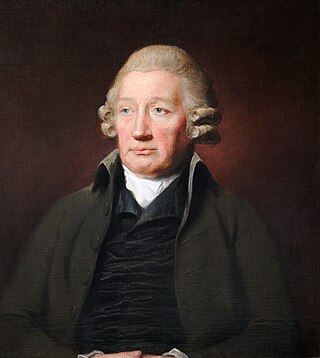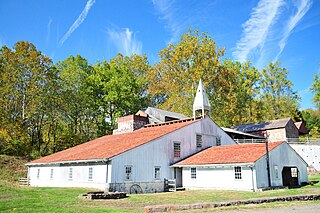

The Duddon furnace (Grid Reference SD 197883) is a surviving charcoal-fuelled blast furnace near Broughton-in-Furness in Cumbria. It is on the west side of the River Duddon in the parish of Millom and formerly in Cumberland.


The Duddon furnace (Grid Reference SD 197883) is a surviving charcoal-fuelled blast furnace near Broughton-in-Furness in Cumbria. It is on the west side of the River Duddon in the parish of Millom and formerly in Cumberland.
The furnace was originally established as a joint venture of the Cunsey Company and the Backbarrow Company in 1736, [1] [2] but the Backbarrow Company sold their share to the Cunsey Company in 1741. [3] The Cunsey Company already owned Cunsey Furnace and Spark Forge, but they closed Cunsey Furnace in 1750, [4] [5] thus becoming the Duddon Company. The partners in the Cunsey Company in 1737 were Edward Hall of Cranage, Warine Falkner of Rugeley, Thomas Cotton of Eardley (Cheshire) and Edward Kendall of Stourbridge. [1] Following the deaths of several partners, the firm became Jonathan Kendall & Co. They also built Argyll Furnace (also called Craleckan or Goatfield) in 1755. [6] The ironworks was managed by William Latham, who between 1772 and 1775 was shipping pig iron to Warren Sayes of Chepstow, but the sales were managed by Jonathan Kendall. [7] Henry Kendall (a partner) died at Ulverston in 1787. [8] William Latham's sons Richard and Joseph renewed the lease in 1790. They continued the works until 1828, when they sold it to Harrison Ainslie and Co., who operated it until 1867. [9]
The furnace stack, of local stone, is intact to its full height of 29 feet, but the hearth has been removed. It was powered from a leat from the River Duddon and was blown (at least latterly) by blowing cylinders, described by Morton. [10] The bridge, leading to the charging platform, has rooms under it used for workers' housing. The charcoal barn is 100 feet long, [11] and the iron ore store also survives. The site was investigated archaeologically in the 1980s, but only interim reports from this have been published. [12]

Millom is a town and civil parish on the north shore of the estuary of the River Duddon in southernmost Cumberland, Cumbria, England. It is situated just outside the Lake District National Park, about six miles north of Barrow-in-Furness and 26 mi (42 km) south of Whitehaven.

A blast furnace is a type of metallurgical furnace used for smelting to produce industrial metals, generally pig iron, but also others such as lead or copper. Blast refers to the combustion air being supplied above atmospheric pressure.

John "Iron-Mad" Wilkinson was an English industrialist who pioneered the manufacture of cast iron and the use of cast-iron goods during the Industrial Revolution. He was the inventor of a precision boring machine that could bore cast iron cylinders, such as cannon barrels and piston cylinders used in the steam engines of James Watt. His boring machine has been called the first machine tool. He also developed a blowing device for blast furnaces that allowed higher temperatures, increasing their efficiency, and helped sponsor the first iron bridge in Coalbrookdale. He is notable for his method of cannon boring, his techniques at casting iron and his work with the government of France to establish a cannon foundry.

The Furness Railway (Furness) was a railway company operating in the Furness area of Lancashire in North West England.

Furness is a peninsula and region of Cumbria in northwestern England. Together with the Cartmel Peninsula it forms North Lonsdale, historically an exclave of Lancashire. On 1 April 2023 it became part of the new unitary authority of Westmorland and Furness.

A bloomery is a type of metallurgical furnace once used widely for smelting iron from its oxides. The bloomery was the earliest form of smelter capable of smelting iron. Bloomeries produce a porous mass of iron and slag called a bloom. The mix of slag and iron in the bloom, termed sponge iron, is usually consolidated and further forged into wrought iron. Blast furnaces, which produce pig iron, have largely superseded bloomeries.

The Brathay is a river of north-west England. Its name comes from Old Norse and means broad river. It rises at a point 1289 feet above sea level near the Three Shire Stone at the highest point of Wrynose Pass in the Lake District. Its catchment area includes the northern flanks of Wetherlam, Great Carrs and others of the Furness Fells, as well as a substantial area of the Langdale Fells.

Halton-with-Aughton is a civil parish and electoral ward located 3 miles (5 km) east of Lancaster, England, on the north bank of the River Lune. The main settlement is the village of Halton, or Halton-on-Lune, in the west, and the parish stretches to the hamlet of Aughton in the east. It lies in the City of Lancaster district of Lancashire, and has a population of 2,227, down from 2,360 in 2001.

Abraham Darby, in his later life called Abraham Darby the Elder, now sometimes known for convenience as Abraham Darby I, was an English ironmaster and foundryman. Born into an English Quaker family that played an important role in the Industrial Revolution, Darby developed a method of producing pig iron in a blast furnace fuelled by coke rather than charcoal. This was a major step forward in the production of iron as a raw material for the Industrial Revolution.

Askam is a railway station on the Cumbrian Coast Line, which runs between Carlisle and Barrow-in-Furness. The station, situated 6 miles (10 km) north of Barrow-in-Furness, serves the villages of Askam-in-Furness and Ireleth in Cumbria. It is owned by Network Rail and managed by Northern Trains.

Hopewell Furnace National Historic Site in southeastern Berks County, near Elverson, Pennsylvania, is an example of an American 19th century rural iron plantation, whose operations were based around a charcoal-fired cold-blast iron blast furnace. The significant restored structures include the furnace group (blast furnace, water wheel, blast machinery, cast house and charcoal house), as well as the ironmaster's house, a company store, the blacksmith's shop, a barn and several worker's houses.

A finery forge is a forge used to produce wrought iron from pig iron by decarburization in a process called "fining" which involved liquifying cast iron in a fining hearth and removing carbon from the molten cast iron through oxidation. Finery forges were used as early as the 3rd century BC in China. The finery forge process was replaced by the puddling process and the roller mill, both developed by Henry Cort in 1783–4, but not becoming widespread until after 1800.
Seend Ironstone Quarry and Road Cutting is a 3 acres (1.2 ha) Geological Site of Special Scientific Interest at Seend in Wiltshire, England, notified in 1965. The site contains facies of Lower Greensand containing specimens of fauna not found elsewhere.

Ferrous metallurgy is the metallurgy of iron and its alloys. The earliest surviving prehistoric iron artifacts, from the 4th millennium BC in Egypt, were made from meteoritic iron-nickel. It is not known when or where the smelting of iron from ores began, but by the end of the 2nd millennium BC iron was being produced from iron ores in the region from Greece to India, and sub-Saharan Africa. The use of wrought iron was known by the 1st millennium BC, and its spread defined the Iron Age. During the medieval period, smiths in Europe found a way of producing wrought iron from cast iron using finery forges. All these processes required charcoal as fuel.

Askam and Ireleth is a civil parish close to Barrow-in-Furness in Westmorland and Furness, Cumbria, England. Historically part of Lancashire, it originally consisted of two separate coastal villages with different origins and histories which, in recent times, have merged to become one continuous settlement. In the 2001 census the parish had a population of 3,632, reducing at the 2011 census to 3,462.

Dyfi Furnace is a restored mid 18th century charcoal fired blast furnace used for smelting iron ore. It has given its name to the adjoining hamlet of Furnace.
The firm of Harrison Ainslie & Co. was a British firm of ironmasters and iron ore merchants, selling high quality haematite from their mines on Lindal Moor to smelters in Glasgow, Scotland, South Wales and the Midlands. From a 21st-century perspective, they are more interesting as the last operators of charcoal-fired blast furnaces in Great Britain. Their furnaces were stone-built, water-powered, and much smaller than the coke-fired furnaces of the same era.

Low Wood Gunpowder Works was a gunpowder mill founded in Furness, England, at the end of the 18th century. It became a significant supplier, and survived as a business until taken over by Imperial Chemical Industries around 1930. The works has been disused since 1935.

The Bonawe Iron Furnace, was an industrial complex located in Bonawe, Lorn District, Scotland. It operated in the middle of the eighteenth century, with the aim of producing pig iron. Central to this complex was a charcoal fired blast furnace.
Coordinates: 54°17′02″N3°14′08″W / 54.2840°N 3.2355°W